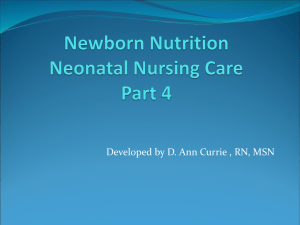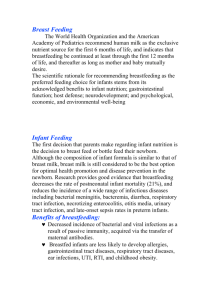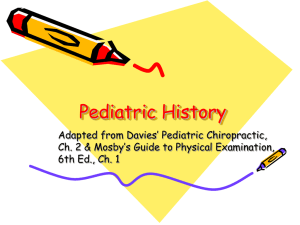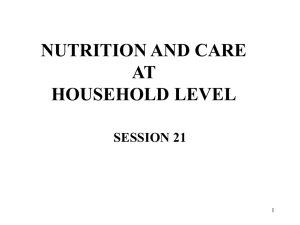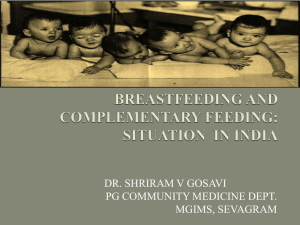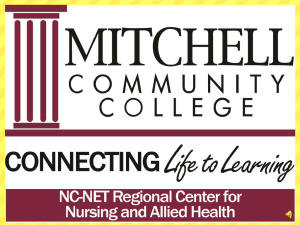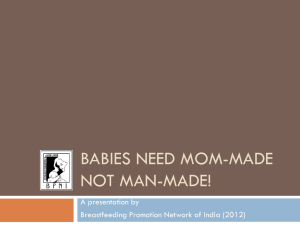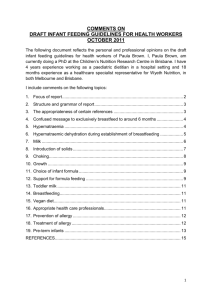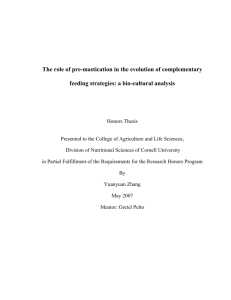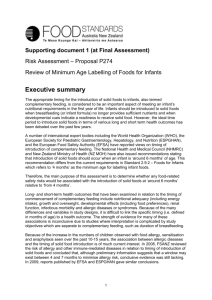AAMCFHN_Submission_Draft_ Infant_ Feeding_ Guidelines
advertisement
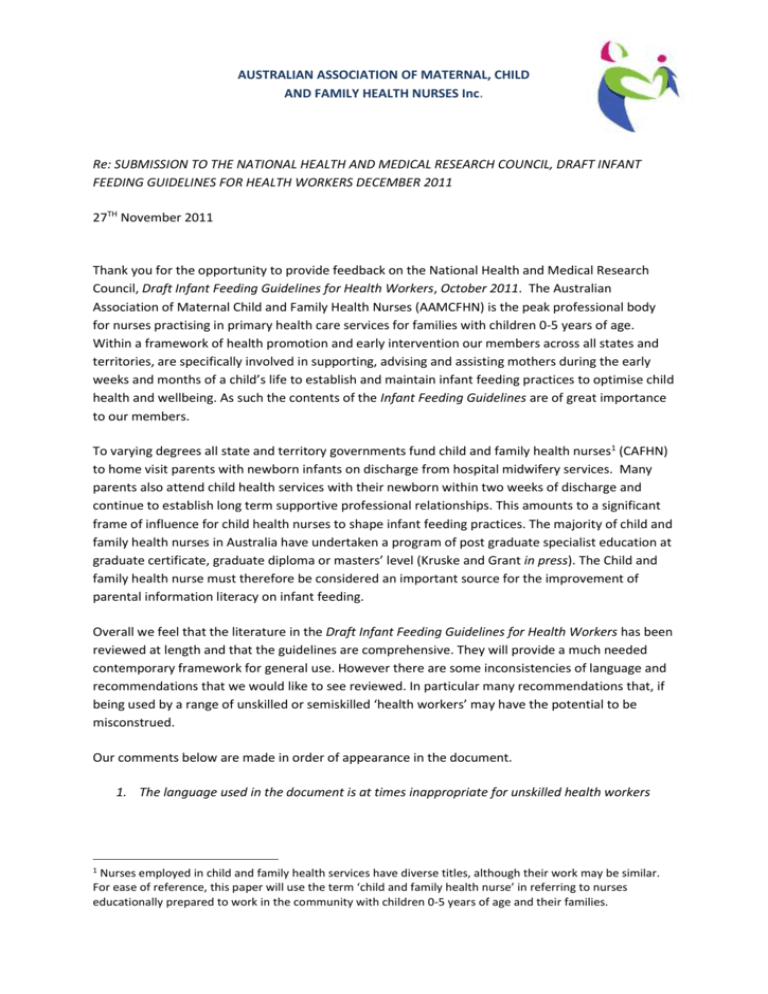
AUSTRALIAN ASSOCIATION OF MATERNAL, CHILD AND FAMILY HEALTH NURSES Inc. Re: SUBMISSION TO THE NATIONAL HEALTH AND MEDICAL RESEARCH COUNCIL, DRAFT INFANT FEEDING GUIDELINES FOR HEALTH WORKERS DECEMBER 2011 27TH November 2011 Thank you for the opportunity to provide feedback on the National Health and Medical Research Council, Draft Infant Feeding Guidelines for Health Workers, October 2011. The Australian Association of Maternal Child and Family Health Nurses (AAMCFHN) is the peak professional body for nurses practising in primary health care services for families with children 0-5 years of age. Within a framework of health promotion and early intervention our members across all states and territories, are specifically involved in supporting, advising and assisting mothers during the early weeks and months of a child’s life to establish and maintain infant feeding practices to optimise child health and wellbeing. As such the contents of the Infant Feeding Guidelines are of great importance to our members. To varying degrees all state and territory governments fund child and family health nurses1 (CAFHN) to home visit parents with newborn infants on discharge from hospital midwifery services. Many parents also attend child health services with their newborn within two weeks of discharge and continue to establish long term supportive professional relationships. This amounts to a significant frame of influence for child health nurses to shape infant feeding practices. The majority of child and family health nurses in Australia have undertaken a program of post graduate specialist education at graduate certificate, graduate diploma or masters’ level (Kruske and Grant in press). The Child and family health nurse must therefore be considered an important source for the improvement of parental information literacy on infant feeding. Overall we feel that the literature in the Draft Infant Feeding Guidelines for Health Workers has been reviewed at length and that the guidelines are comprehensive. They will provide a much needed contemporary framework for general use. However there are some inconsistencies of language and recommendations that we would like to see reviewed. In particular many recommendations that, if being used by a range of unskilled or semiskilled ‘health workers’ may have the potential to be misconstrued. Our comments below are made in order of appearance in the document. 1. The language used in the document is at times inappropriate for unskilled health workers 1 Nurses employed in child and family health services have diverse titles, although their work may be similar. For ease of reference, this paper will use the term ‘child and family health nurse’ in referring to nurses educationally prepared to work in the community with children 0-5 years of age and their families. The purpose of the document is stated as being ‘to support optimum infant nutrition by providing a review of the evidence, and clear evidence-based recommendations on infant feeding for health workers’ (p. 3). Following WHO (1981 ) ‘health workers’ are defined as ‘a professional or non professional person working in a component of a health care system: includes voluntary unpaid workers (p. 27). We recognise that targeting information to such a broad audience is challenging, however, if the intended audience includes voluntary unpaid and perhaps unskilled health workers, the language may be too academic or wordy to be useful. For example in relation to providing advice on safe levels of drinking alcohol, the recommendation on p. 6 states ‘provide advice on the recommended maximum intake level and the optimal timing of breastfeeding in relation to intake’. It would be clearer for non professional health workers if the recommended levels and timing were included in the recommendations. Further, on p. 7 it states ‘limit an infant’s fruit juice intake’. It would be clearer for health workers to say ‘avoid fruit juices’. As child and family health nurses, we primarily work on an individual level with mothers and families. This means that we are very experienced in making sense of how parents, skilled and unskilled take up health messages. Infant feeding guidelines in this document need to be explicit with no potential for misinterpretation. 2. Breast feeding recommendations are not consistent throughout and may lead to misinterpretation 2.1 The aim for infants to exclusively breastfeed until 6 months is clearly stated on p.4. This statement is diluted throughout the document commencing on p. 3 where it indicates that ‘as many as possible’ infants should be exclusively breast fed. While our concern may seem semantic, the construction of what is ‘possible’ and ‘not possible’ can be easily misconstrued due to a range of tightly held personal beliefs around breastfeeding, particularly where health workers are unskilled. 2.2 The promotion of breast feeding duration is articulated as: ‘Encourage, support and promote exclusive breastfeeding to around six months of age. Continue breastfeeding with appropriate complementary foods until 12 months of age and beyond. While breastfeeding is recommended for six to 12 months and beyond, any breastfeeding is beneficial to the infant and mother’ (p. 5). As child health nurses this makes sense, however again, it could easily be misinterpreted. In the child health workplace parents often interpret this information to mean that it is adequate to stop breastfeeding at 6 months. We would recommend that this section be reworded to recommend breastfeeding for 12 months minimum, with the inclusion of additional foods from 6 months. This may have the added benefit of parents weaning directly onto cow’s milk at 12 months and drinking from a cup rather than a bottle, which would mitigate a whole range of additional child health issues around sleep and speech development. 2.3 The breast feeding recommendation also suggests that health workers ‘pay particular attention to the importance of correct attachment and positioning when breastfeeding’ (p. 5). From our experience any recommendation suggesting that there is one universal ‘correct’ way to achieve an outcome results in parents on an individual level being overly concerned that they are not ‘correct’. Minimally, this needs to be reworded to remove the word ‘correct’. 2.4 While the evidence clearly suggests that where a mother has support of an infant’s father, breast feeding outcomes are improved. We think that the sentence ‘...where the mother has the support and encouragement of the infant’s father, other family members, the hospital, and the community’ (p. 3) should also include the mother’s partner. Where the infant’s father is not present and an alternate maternal partner is present, the support for breastfeeding shown by this person can result in similar improved breastfeeding outcomes. 2.5 The Guidelines recommend that parents are informed of the benefits of breastfeeding (p.7) and that ‘if supplementary feeding is needed in hospital, it should only be given for specific medical indications and with the mother’s agreement’. While this is certainly appropriate we feel that it is not worded explicitly enough. From our experience ‘a specific medical indication’ may be interpreted as painful nipples, which is not an indicator for the introduction of formula. It would be helpful for this to read unequivocally such as ‘Commercial infant formulas are not available in Australian hospitals providing maternity services unless there are specific medical indications and only given where ordered by a medical officer’ 3. Use of the term ‘spoon foods’ is misleading and culturally unaware People from many cultures around the world introduce foods other than milk via a range of modes including their fingers. To suggest that introduction of these foods should be defined by spoon use is culturally unaware and disrespectful. Once soft solid foods are introduced and managed, infants progress rapidly through to soft lump style foods, which is often eaten by the child using their own hands as in the case of soft finger foods. The Guidelines refer exclusively to ‘spoon’ foods prior to 12 months. For the healthy development of speech and language infants need to progress through a range of increasingly textured foods including firm finger foods. There needs to be explicit mention of finger foods as the omission of discussing them may lead health workers to understand that they are not to be offered before 12 months. Perhaps references to ‘spoon’ foods could be changed to ‘spoon and finger’ foods. On p. 8 the guidelines recommend: ‘Ensure that spoon foods are of acceptable texture (no nuts or similar hard foods) and taste’. This could be misconstrued by health workers as meaning no nuts at all. This could simply be changed to state ‘no whole nuts’. 4. The recommendation that parents should consult a doctor if they are concerned about their infants’ bowel motions is inappropriate as a primary health care strategy The Guidelines recommend that ‘to avoid unnecessary intervention, inform parents about the wide variation in normal bowel function in infants (particularly those who are breastfed). If parents are concerned, they should consult a doctor’ (p. 10). We would prefer that this recommendation directs parents to child and family health nurses as a primary health care strategy. CAFHNs are the early childhood, health care professionals with whom the majority of parents would discuss non medical health care issues. The CAFHN is more likely to use a primary strategy of improving parental health literacy; discuss and recommend a range of management options relating to infant feeding as during ‘infancy true constipation is infrequent’ (p. 10). The child health nurse would make a referral to a general practitioner if indicated. Primary consultation with CAFHNs is likely to reduce pharmacological interventions for infants who are most likely not experiencing true constipation. 5. The recommendation on use of fluoridated water does not contain enough information for unskilled health professionals. The recommendation for use of fluoridated water states ‘for children between the ages of six months and two years who are living in areas where the household water supply is not fluoridated, further health care professional advice should be sought for the infant’s location’ (p. 11). This information is not enough for health professionals. They need a recommendation of where to go for further information. They also need a more specific suggestion such as ‘children between the ages of six months and two years who are living in areas where the household water supply is not fluoridated fluoride should commence teeth cleaning with fluoridated toothpaste as soon as teeth erupt with minimal rinsing’. 6. WHO Percentile growth charts should be adopted for practice in Australia The document indicates that the Australian government health officials are reviewing growth charts for use in Australia (p. 70). As a key strategy to improve breast feeding rates we argue that use of WHO percentile growth charts, based on breast fed infants should be adopted as a matter of urgency and should be core to these guidelines . Use of growth charts based on bottle fed infants creates unrealistic expectations for parents as indeed it may do for health workers who are not aware of their foundation. References Kruske S & Grant J (in press) Educational preparation for maternal child and family health nurses in Australia, International Nursing Review, accepted 22nd November 2011
